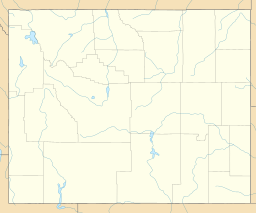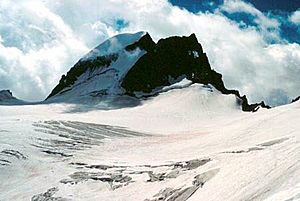Gannett Peak facts for kids
Quick facts for kids Gannett Peak |
|
|---|---|

West face of Gannett Peak
|
|
| Highest point | |
| Elevation | 13,810 ft (4,210 m) |
| Prominence | 7,077 ft (2,157 m) |
| Isolation | 290.36 mi (467.29 km) |
| Parent peak | Longs Peak |
| Listing |
|
| Geography | |
| Location | Fremont and Sublette Counties, Wyoming, United States |
| Parent range | Wind River Range |
| Topo map | USGS Gannett Peak |
| Climbing | |
| First ascent | 1922 by A. Tate and F. Stahlnaker |
| Easiest route | rock/ice climb |
Gannett Peak is the highest mountain in the U.S. state of Wyoming. It stands tall at about 13,810 feet (4,209 meters) above sea level. This impressive peak is located in the Wind River Range, a part of the Rocky Mountains. It lies within the Bridger Wilderness of the Bridger-Teton National Forest.
Gannett Peak is found right on the Continental Divide. This imaginary line separates rivers that flow to the Pacific Ocean from those that flow to the Atlantic. The mountain sits on the border between Fremont and Sublette counties. It is the second most prominent peak in Wyoming, meaning it rises very high above the land around it.
Contents
About Gannett Peak
Gannett Peak is a very important mountain in the Rocky Mountains. It is the highest point in the central part of this huge mountain chain. This includes the states of Wyoming, Idaho, and Montana. The mountain was named in 1906 after Henry Gannett, a famous American geographer. It is also the highest point in the entire Wind River Range.
The mountain's slopes are part of two large national forests. These are the Bridger-Teton National Forest and the Shoshone National Forest. Gannett Peak is also the highest point within the larger Greater Yellowstone Ecosystem. This is a vast area of wild land that includes Yellowstone National Park. It is also the tallest peak in the Rocky Mountains outside of Colorado.
Glaciers of Gannett Peak
Gannett Peak is home to several large glaciers. A glacier is a huge, slow-moving river of ice. The Gannett Glacier covers about 896 acres (3.6 square kilometers) on the northern side of the mountain. It is likely the biggest single glacier in the American Rocky Mountains.
Other glaciers can be found around the peak as well. The Minor Glacier is located on the western side. The Dinwoody Glacier and Gooseneck Glacier are found on the southeast side of the mountain. These glaciers are important parts of the mountain's natural environment.
Climbing Challenges
Gannett Peak is in a very remote and wild area. Because of its location, high elevation, and tough weather, it is a very difficult mountain to climb. Many mountaineers consider it one of the hardest U.S. state high points to reach. Only Denali in Alaska and possibly Granite Peak in Montana are thought to be tougher.
Staying Safe on the Mountain
When exploring the Wind River Range, it's important to be aware of potential dangers. One concern is encountering bears. Other things to watch out for include bugs, wildfires, and unpredictable snow conditions. Even in summer, temperatures can drop very low at night.
Climbing mountains like Gannett Peak requires great care. Hikers and climbers must always be careful to avoid falls from steep cliffs. It's also important to watch out for falling rocks. Always be prepared for changing weather and challenging terrain when visiting this beautiful but rugged area.



